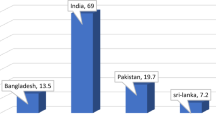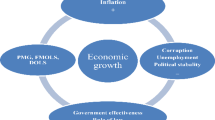Abstract
The surprisingly limited literature investigating whether there exists a long-run association between trade liberalization and income inequality finds strong evidence for it. We point out a possible model misspecification due to ignoring the presence of cross-section dependence. Using a panel of 15 EU countries in the 1985–2017 period we show that there is strong evidence for the presence of cross-section dependence. Therefore, we use so-called second-generation procedures (which are robust to cross-section dependence) and find no evidence that trade liberalization and income inequality share a long-run cointegrating relationship in the European Union.














Similar content being viewed by others
Notes
Squalli and Wilson (2011) define an open economy as one which exhibits (1) a relatively high share of trade relative to overal economic activity and (2) an important level of interaction and interconnectedness with the rest of the world. They constructed the composite trade share index as a measure, which captures these two dimensions of trade openness.
We note that the evidence for cross-section dependence in the disposable income inequality panel is not as strong as other variables as the null of no cross-section depedendence is only rejected at the 10% significance level (vs 1% for other variables).
References
Andrews DWK (2005) Cross-section regression with common shocks. Econometrica 73(5):1551–85
Asteriou D, Dimelis S, Moudatsou A (2014) Globalization and income inequality: a panel data econometric approach for the Eu27 countries. Econ Model 36:592–99
Babones SJ (2008) Income inequality and population health: correlation and causality. Social Sci Med 66(7):1614–26
Bahmani-Oskooee M, Hegerty SW, Wilmeth H (2008) Short-run and long-run determinants of income inequality: evidence from 16 countries. J Post Keynes Econ 30(3):463–84
Balassa B (1976) Types of economic integration. In: Economic integration: worldwide, regional, sectoral. 17–40. Springer
Baldwin RE, Charles W (2006) The economics of European integration. McGraw-Hill Education Berkshire
Baltagi Badi H, Hashem PM (2007) Heterogeneity and cross section dependence in panel data models: theory and applications introduction. J Appl Econ 22(2):229–32
Banerjee A, Marcellino M, Osbat C (2005) Testing for PPP: should we use panel methods? Empirical Econ 30(1):77–91
Barusman AF, Barusman YS (2017) The impact of international trade on income inequality in the united states since 1970’s. Eur Res Stud J 20(4A):35–50
Basak GK, Das S (2017) Intercept homogeneity test for fixed effect models under cross-sectional dependence: some insights. J Econ Methods. https://doi.org/10.1515/jem-2015-0004
Bergh A, Nilsson T (2010) Do liberalization and globalization increase income inequality? Eur J Polit Econ 26(4):488–505
Bogliaccini JA (2013) Trade liberalization, deindustrialization, and inequality: evidence from middle-income latin American countries. Latin Am Res Rev 48:79–105
Bogliacino F (2014) Inequality and Europe 2020. Intereconomics 49(5):288–94
Breusch TS, Pagan AR (1980) The lagrange multiplier test and its applications to model specification in econometrics. Rev Econ Stud 47(1):239–53
Brown DK, Stern RM et al (2009) Computable general equilibrium estimates of the gains from US-Canadian trade liberalization. Glob Int Trade Polic 9:425
Cassette A, Fleury N, Petit S (2012) Income inequalities and international trade in goods and services: short-and long-run evidence. Int Trade J 26(3):223–54
Chamberlain G (1984) Panel data. Handb Econ 2:1247–1318
Chong A, Gradstein M (2007) Inequality and institutions. Rev Econ Stat 89(3):454–65
Chudik A, Pesaran MH (2013) Large panel data models with cross-sectional dependence: a survey. CAFE Research Paper. 13:15
Chudik A, Pesaran MH (2015) Common correlated effects estimation of heterogeneous dynamic panel data models with weakly exogenous regressors. J Econ 188(2):393–420
Cohn Theodore H (2016) Global political economy: theory and practice. Routledge
De Loecker D (2011) Product differentiation, multiproduct firms, and estimating the impact of trade liberalization on productivity. Econometrica 79(5):1407–51
De Vogli D, Roberto RM, Gnesotto R, Cornia GA (2005) Has the relation between income inequality and life expectancy disappeared? Evidence from Italy and top industrialised countries. J Epidemiol Commun Health 59(2):158–62
Dreher A (2006) Does globalization affect growth? Evidence from a new index of globalization. Appl Econ 38(10):1091–1110
Elveren AY, Örnek İ, Akel G (2012) Internationalisation, growth and pay inequality: a cointegration analysis for Turkey, 1970–2007. Int Rev Appl Econ 26(5):579–95
Eurostat statistical (2008) External and intra-European union trade. Monthly Statistics-Issue. no. 2
Glomm G, Ravikumar B (2003) Public education and income inequality. Eur J Polit Econ 19(2):289–300
Im KS, Hashem Pesaran M, Shin Y (2003) Testing for unit roots in heterogeneous panels. J Econ 115(1):53–74
Imbruno M (2020) A micro-founded approach to exploring gains from trade integration: evidence from 27 EU countries. World Econ 44:706
Jaumotte F, Lall S, Papageorgiou C (2013) Rising income inequality: technology, or trade and financial globalization? IMF Econ Rev 61(2):271–309
Kao C (1999) Spurious regression and residual-based tests for cointegration in panel data. J Econ 90(1):1–44
Kawachi I, Kennedy BP (1997) The relationship of income inequality to mortality: does the choice of indicator matter? Social Sci Med 45(7):1121–27
Levin A, Lin C-F, Chu C-SJ (2002) Unit root tests in panel data: asymptotic and finite-sample properties. J Econ 108(1):1–24
Lim GC, Paul D McNelis (2014) Income inequality, trade and financial openness. New Perspectives
Meschi E, Vivarelli M (2009) Trade and income inequality in developing countries. World Dev 37(2):287–302
Milanovic B, Squire L (2007) 4 Does tariff liberalization increase wage inequality? University of Chicago Press,
Morley SA, Machado R, Pettinato S (1999) Indexes of structural reform in Latin America. United Nations, Economic Comm. for Latin America; the Caribbean
Neagu O, Dumiter F, Braica A (2016) Inequality, economic growth and trade openness: a case study for central and eastern European countries (ECE). Amfiteatru Econ J 18(43):557–74
Olley GS, Ariel P (1992) The dynamics of productivity in the telecommunications equipment industry. National Bureau of Economic Research
Pavcnik N (2002) Trade liberalization, exit, and productivity improvements: evidence from Chilean plants. Rev Econ Stud 69(1):245–76
Pedroni P (1999) Critical values for cointegration tests in heterogeneous panels with multiple regressors. Oxford Bull Econ Stat 61(S1):653–70
Pesaran MH (2004) General diagnostic tests for cross section dependence in panels
Pesaran MH (2007) A simple panel unit root test in the presence of cross-section dependence. J Appl Economet 22(2):265–312
Pesaran MH, Shin Y, Smith RJ (2001) Bounds testing approaches to the analysis of level relationships. J Appl Economet 16(3):289–326
Phillips PCB, Donggyu S (2003) The elusive empirical shadow of growth convergence
Phillips PCB, Sul D (2007) Bias in dynamic panel estimation with fixed effects, incidental trends and cross section dependence. J Econ 137(1):162–88
Ray S (2012) Globalization and economic growth in India: a granger causality approach. JL Pol’y Glob 2:18
Reuveny R, Li Q (2003) Economic openness, democracy, and income inequality: an empirical analysis. Comp Pol Stud 36(5):575–601
Sarafidis V, Robertson D (2009) On the impact of error cross-sectional dependence in short dynamic panel estimation. Economet J 12(1):62–81
Shen Y, Yao Y (2008) Does grassroots democracy reduce income inequality in China? J Public Econ 92(10–11):2182–98
Shleifer A, Vishny RW (1993) Corruption. Q J Econ 108(3):599–617
Smarzynska JB (2004) Does foreign direct investment increase the productivity of domestic firms? In search of spillovers through backward linkages. Am Econ Rev 94(3):605–27
Solt F (2016) The standardized world income inequality database. Soc Sci Q 97(5):1267–81
Solt F (2018) The standardized world income inequality database. Harvard Dataverse
Squalli J, Wilson K (2011) A new measure of trade openness. World Econ 34(10):1745–70
Sun P, Tan Y, Yang G (2020) Export, FDI and the welfare gains from trade liberalization. Econ Modell 92:230
Sylwester K (2000) Income inequality, education expenditures, and growth. J Dev Econ 63(2):379–98
Sylwester K (2002) Can education expenditures reduce income inequality? Econ Educ Rev 21(1):43–52
Székely M, Claudia S (2012) Did trade openness affect income distribution in Latin America? Evidence for the years 1980-2010
Tang H (2014) World trade report 2013-Factors shaping the future of world tradeworld trade organization, 2013. World Trade Rev 13(4):733–35
Taylor AM (2002) Globalization, trade, and development: some lessons from history. Natl Bureau Econ Res
Tridico P (2018) The determinants of income inequality in OECD countries. Camb J Econ 42(4):1009–42
Tybout JR, Westbrook MD (1995) Trade liberalization and the dimensions of efficiency change in Mexican manufacturing industries. J Int Econ 39(1–2):53–78
Van Biesebroeck J (2005) Exporting raises productivity in sub-Saharan African manufacturing firms. J Int Econ 67(2):373–91
Westerlund J (2007) Testing for error correction in panel data. Oxford Bull Econ Stat 69(6):709–48
World Bank (2020) Worldwide Governance Indicators. www.govindicators.org
Author information
Authors and Affiliations
Corresponding author
Additional information
Responsible Editor: Jesus Crespo Cuaresma.
Publisher's Note
Springer Nature remains neutral with regard to jurisdictional claims in published maps and institutional affiliations.
Rights and permissions
About this article
Cite this article
Akyuz, M., Gueye, G.N. & Karul, C. Long-run dynamics between trade liberalization and income inequality in the European Union: a second generation approach. Empirica 49, 769–792 (2022). https://doi.org/10.1007/s10663-022-09539-8
Accepted:
Published:
Issue Date:
DOI: https://doi.org/10.1007/s10663-022-09539-8




